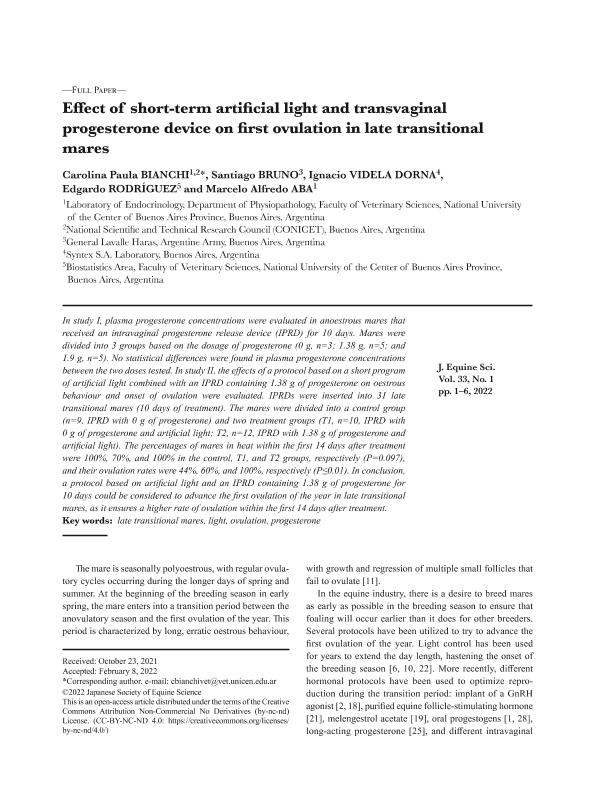Artículo
Effect of short-term artificial light and transvaginal progesterone device on first ovulation in late transitional mares
Bianchi, Carolina Paula ; Bruno, Santiago; Videla Dorna, Ignacio; Rodríguez, Edgardo José; Aba, Marcelo Alfredo
; Bruno, Santiago; Videla Dorna, Ignacio; Rodríguez, Edgardo José; Aba, Marcelo Alfredo
 ; Bruno, Santiago; Videla Dorna, Ignacio; Rodríguez, Edgardo José; Aba, Marcelo Alfredo
; Bruno, Santiago; Videla Dorna, Ignacio; Rodríguez, Edgardo José; Aba, Marcelo Alfredo
Fecha de publicación:
04/2022
Editorial:
Japanese Society of Equine Science
Revista:
Journal of Equine Science
ISSN:
1340-3516
e-ISSN:
1347-7501
Idioma:
Inglés
Tipo de recurso:
Artículo publicado
Clasificación temática:
Resumen
In study I, plasma progesterone concentrations were evaluated in anoestrous mares that received an intravaginal progesterone release device (IPRD) for 10 days. Mares were divided into 3 groups based on the dosage of progesterone (0 g, n=3; 1.38 g, n=5; and 1.9 g, n=5). No statistical differences were found in plasma progesterone concentrations between the two doses tested. In study II, the effects of a protocol based on a short program of artificial light combined with an IPRD containing 1.38 g of progesterone on oestrous behaviour and onset of ovulation were evaluated. IPRDs were inserted into 31 late transitional mares (10 days of treatment). The mares were divided into a control group (n=9, IPRD with 0 g of progesterone) and two treatment groups (T1, n=10, IPRD with 0 g of progesterone and artificial light; T2, n=12, IPRD with 1.38 g of progesterone and artificial light). The percentages of mares in heat within the first 14 days after treatment were 100%, 70%, and 100% in the control, T1, and T2 groups, respectively (P=0.097), and their ovulation rates were 44%, 60%, and 100%, respectively (P≤0.01). In conclusion, a protocol based on artificial light and an IPRD containing 1.38 g of progesterone for 10 days could be considered to advance the first ovulation of the year in late transitional mares, as it ensures a higher rate of ovulation within the first 14 days after treatment.
Palabras clave:
LATE TRANSITIONAL MARES
,
LIGHT
,
OVULATION
,
PROGESTERONE
Archivos asociados
Licencia
Identificadores
Colecciones
Articulos(CIVETAN)
Articulos de CENTRO DE INVESTIGACION VETERINARIA DE TANDIL
Articulos de CENTRO DE INVESTIGACION VETERINARIA DE TANDIL
Citación
Bianchi, Carolina Paula; Bruno, Santiago; Videla Dorna, Ignacio; Rodríguez, Edgardo José; Aba, Marcelo Alfredo; Effect of short-term artificial light and transvaginal progesterone device on first ovulation in late transitional mares; Japanese Society of Equine Science; Journal of Equine Science; 33; 1; 4-2022; 1-6
Compartir
Altmétricas



